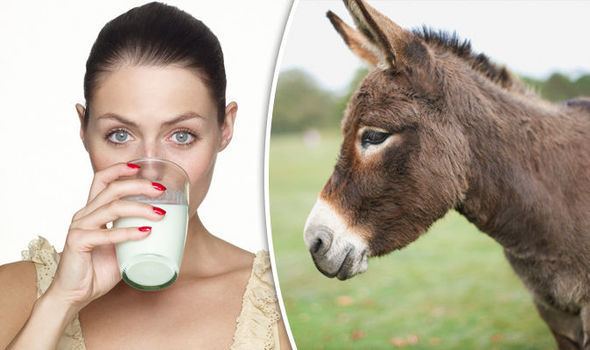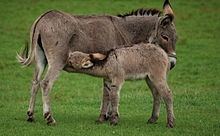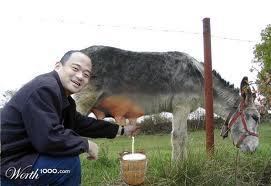 | ||
Similar Mare milk, Argan oil, Pule cheese, Shea butter, Argan | ||
Donkey milk (or ass milk/jenny milk) is the milk given by the domesticated donkey (Equus asinus). It has been used since antiquity for cosmetic purposes as well as infant nutrition.
Contents
- The world s most expensive cheese is made from donkey milk
- History
- Gross composition
- Functional and bioactive components
- Substitute for breast milk
- Natural hypoallergenic milk for infants
- Fermented donkey milk
- Koumiss
- Cosmetics with donkey milk
- Types
- Donkey milk lyophilized freeze dried
- References

The world s most expensive cheese is made from donkey milk
History
The use of asinine milk by humans for alimentary and cosmetic purposes has been popular since Egyptian antiquity.

Hippocrates (460 – 370 BC), the father of medicine, was the first to write of the medicinal virtues of donkey milk. In the Roman era donkey milk was recognized as a common remedy, Pliny the Elder (23 – 79 AD) in his encyclopedic work, Naturalis Historia, wrote extensively about its health benefits, but it wasn’t until the Renaissance that the first real scientific consideration was given to donkey milk. Subsequently, the famous French naturalist, Georges-Louis Leclerc (1707- 1788) mentions the benefits of donkey milk in his Histoire naturelle and Pauline Bonaparte (1780-1825), Napoleon’s sister, is also reported to have used Donkey milk for her skin’s health care. In France in the nineteenth century, Dr. Parrot of Hospital des Enfants Assistès spread the practice of bringing babies motherless directly to the donkey’s nipple (Bullettin de l’Académie de médicine, 1882). The donkey’s milk was then sold until the twentieth century to feed orphaned infants and to cure delicate children, the sick and the elderly. For this reason, in Italy, Belgium, Germany, Switzerland many donkeys are born on farms.

The asinine species is considered a seasonal polyestrous one, but the latitude in which the farm is located can greatly influence the reproduction cycle. The female is normally pregnant for about 12 months.

Donkey milk production differs greatly from that of conventional dairy species, especially in terms of milk supply which is much more limited. The equid mammary gland has a low capacity (max 2,5 L) and a part of the milk production should be left to the foal and that milking may be carried out two or three hours after separation from the foal. Donkeys should be milked from 20 to 90 d after foaling for three times a day. A female gives between 0.5 and 1.3 litres of milk a day for about 6–7 months. . The variability of donkey milk production is due to many factors, such as individual milkability, nutrition, genetics, management of reproduction, etc., in addition to milking management.

Generally, a donkey farm (breeding), aimed at milk’s production are small, with some tens of heads and rarely more. In Europe and specifically in Emilia Romagna (Italy) there is only one very great asinine farm with 800 head.
Gross composition

Published data on donkey milk gross composition confirm the closer resemblance to breast milk for lactose, protein and ash levels when compared with cow, sheep and goat milk. Despite the high lactose content of donkey milk the average fat content is lower for this purpose, when used in infant nutrition, donkey milk is usually supplemented with vegetal oil (4 mL 100 mL−1 milk) to conform to human milk energy
The casein to whey protein ratio in donkey milk was lower compared to the value on cow milk.

The non-protein nitrogen (NPN) accounts for an average of 16% of total nitrogen in donkey milk, is much closer than values reported for human milk (20%) but higher than those of domestic ruminants (5%).

The amino acid profile of the donkey milk proteins shows a very similar percentage of essential amino acids (36.7 e 38.2 g amino acid /100 g protein) than in human milk proteins (40.7 g amino acid /100 g protein), according to Guo et al.
Functional and bioactive components
Among the functional proteins detected in donkey milk, there are molecules active in antimicrobial protection such as lysozyme and lactoferrin. The lactoferrin content of donkey milk is intermediate between the lower values of cow milk and the higher values of human milk. Lactoferrin inhibits the growth of iron-dependent bacteria in the gastrointestinal tract. This inhibits certain organisms, such as coliforms and yeast, that require iron. Lysozyme in donkey milk is present in large amounts, indeed ranges from 1.0 mg/mL to 4 mg/mL, depending on the analytical method used (chemical or microbiological); this substance is present also in human (0.12 mg/ml) but only in trace amounts in cow and goat milk. Lysozyme in donkey milk is highly thermo-stable and is very resistant to acid and protease and may play a significant role in the intestinal immune response.
In donkey mammary secretion, defatted or not, growth factors and hormones have also been determined. In detail, donkey mammary secretions contain human-like leptin at levels close to human milk (3.35 e 5.32 ng/mL milk). The bioactive peptides insulin like growth factor 1, ghrelin and triiodothyronine were also found in frozen donkey milk. These molecules, and many others present in human milk, are increasingly receiving attention from a nutraceutical point of view because of their potential direct role in regulating food intake, metabolism, and infant body condition.
Substitute for breast milk
Donkey's milk is used as a substitute for human milk due its lactose, proteins, minerals, and omega-3 fatty acid content. Donkey milk contains immune-enhancing compounds (in particular lysozyme and lactoferrin) to help protect infants from infection and disease. In addition, the flavour and appearance of donkey milk have been found to be attractive to children.
In terms of energy despite the high lactose content of donkey milk the average fat content is lower. When used in infant nutrition, donkey milk is usually supplemented with vegetable oil (4 mL per 100 mL milk) to mimic human milk energy.
Natural hypoallergenic milk for infants
Donkey milk is used as a natural hypoallergenic milk, because it is tolerated by about 90% of infants with food allergies, e.g., cows’ milk protein allergy (CMPA), a common food allergy in childhood with a prevalence of approximately 3% during the first 3 years of life. However the infants tolerance of donkey milk must be evaluated first subjectively, under medical supervision and after carrying out specific allergic tests.
Fermented donkey milk
Equid (donkey and horse) milk can be considered a suitable substrate for probiotic beverage production.
Koumiss
The use of fermented equid milk is an ancient tradition in central Asia, like koumiss or airag, a fermented mares milk very popular in Asia and Russia; but there are also traditional variants made from donkey milk.
In Mongolia, where koumiss is the national drink, people have a saying that ‘kumys cures 40 diseases’.
History
It is said that Cleopatra, Queen of Ancient Egypt, took baths in donkey milk to preserve the beauty and youth of her skin. Legend has it that no less than 700 donkeys were needed to provide the quantity of milk necessary for her daily bath.
This was also the case of Poppaea Sabina (30 – 65), second wife of Roman Emperor Nero, who is referred to in Pliny’s description of the ass milk virtues for the skin:
"It is generally believed that ass milk effaces wrinkles in the face, renders the skin more delicate, and preserves its whiteness : and it is a well-known fact, that some women are in the habit of washing their face with it seven times daily, strictly observing that number. Poppaea, the wife of the Emperor Nero, was the first to practise this; indeed, she had sitting-baths, prepared solely with ass milk, for which purpose whole troops of she- asses used to attend her on her journeys "
The Roman poet Ovid.(43 BC. – 18 d.C.) also in his poem Medicamina Faciei Femineae, suggest beauty masks made with donkey milk.
Pauline Bonaparte (1780–1825), Napoleon’s sister, is also reported to have used ass milk for her skin’s health care.
Cosmetics with donkey milk
In recent years, the cosmetic industry is mainly focused towards products made with natural ingredients and it is oriented to a sustainable consumption. Because of their natural origin, milk components correspond in many fields to the needs of cosmetology.
Recent scientific study on a cream containing of lyophilized donkey milk showed different benefits for the skin. These results are related to the effectiveness of donkey milk components like proteins, minerals, vitamins, essential fatty acids, bioactive enzyme and coenzyme which allow the skin a balanced nourishment and a proper hydration. In particular vitamin C content in donkey milk is almost 4 times more of cow's milk. Donkey milk contain more lactoferrin of cow milk and a considerable mounts of lysozyme, from 1.0 mg/mL to 4 mg/mL (depending on the analytical method used: chemical or microbiological), instead cow's milk only traces. For this reason have the potentiality, when properly formulated, to reduce problem skin with eczema, acne, psoriasis and herpes and properties in calming the irritation symptoms as reported by some authors.
Some authors have preliminarily evaluated whether the use of a face cream made from donkey milk affected the perception of some sensory aspects. The results showed that treated cream resulted appreciated by dry skin consumers for the following sensory aspects: spreadability, total appearance, smoothness, moisturisation and total effectiveness . The overall judgement also resulted highest for face cream made with donkey milk
Today, donkey milk is still used in the manufacture of soaps and creams with donkey's milk.
Types
Donkey milk lyophilized (freeze dried)
This product is made to safeguard the highest biological quality of donkey milk, so to preserve its nutritional, functional and cosmetic properties. This is possible because with freeze-dried the milk is frozen and brought under vacuum at low temperatures. During this process the water is removed by sublimation. The result is approximately ten percent of solid substance what is called donkey milk lyophilized (or freeze dried). It is in powder form easy to reconstitute. The lyophilized product has to be packaged without any oxygen. The durability of donkey milk lyophilized can take 2 year.
Concluding, the treatment of lyophilization (freeze dried) of donkey’s milk demonstrated that the natural colour, flavours, nutrients, bioactive substances of the fresh donkey milk are retained. Instead, with the spray-drying method, another way to dry products, the milk is being heated whereby vitamins and other important bioactive substances will get lost. In addition Freeze-dried don't require chemical preservatives and can be either consumed directly or re hydrated easily. However, this method for its high costs is practiced only by a few companies.
This product it is easy to find in Italy, where it was for the first time put on the market, but can be difficult outside of Europe.
